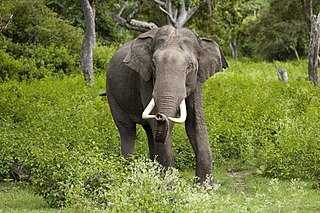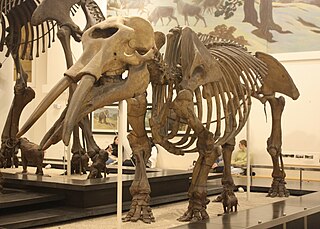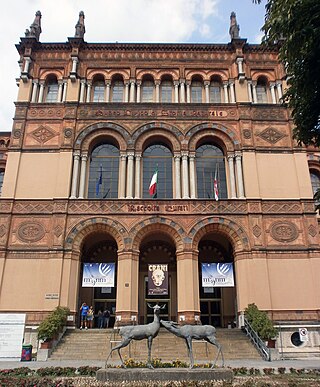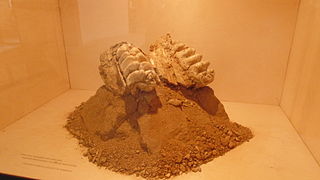
Proboscidea is a taxonomic order of afrotherian mammals containing one living family (Elephantidae) and several extinct families. First described by J. Illiger in 1811, it encompasses the elephants and their close relatives. Three species of elephant are currently recognised: the African bush elephant, the African forest elephant, and the Asian elephant.

A mastodon is a member of the genus Mammut, which was endemic to North America and lived from the late Miocene to the early Holocene. Mastodons belong to the order Proboscidea, the same order as elephants and mammoths. Mammut is the type genus of the extinct family Mammutidae, which diverged from the ancestors of modern elephants at least 27–25 million years ago, during the Oligocene.

Elephantidae is a family of large, herbivorous proboscidean mammals collectively called elephants and mammoths. These are large terrestrial mammals with a snout modified into a trunk and teeth modified into tusks. Most genera and species in the family are extinct. Only two genera, Loxodonta and Elephas, are living.

Platybelodon is an extinct genus of large herbivorous proboscidean mammals related to modern-day elephants, placed in the "shovel tusker" family Amebelodontidae. Species lived during the middle Miocene Epoch in Africa, Asia and the Caucasus.

Gomphotheres are an extinct group of proboscideans related to modern elephants. First appearing in Africa during the Oligocene, they dispersed into Eurasia and North America during the Miocene and arrived in South America during the Pleistocene as part of the Great American Interchange. Gomphotheres are a paraphyletic group ancestral to Elephantidae, which contains modern elephants, as well as Stegodontidae.

Deinotheriidae is a family of prehistoric elephant-like proboscideans that lived during the Cenozoic era, first appearing in Africa, then spreading across South Asia and Europe. During that time, they changed very little, apart from growing much larger in size; by the late Miocene, they had become the largest land animals of their time. Their most distinctive features were their lack of upper tusks and downward-curving tusks on the lower jaw.

Paraceratherium is an extinct genus of hornless rhinocerotoids belonging to the family Paraceratheriidae. It is one of the largest terrestrial mammals that has ever existed and lived from the early to late Oligocene epoch. The first fossils were discovered in what is now Pakistan, and remains have been found across Eurasia between China and the Balkans. Paraceratherium means "near the hornless beast", in reference to Aceratherium, the genus in which the type species P. bugtiense was originally placed.

Anancus is an extinct genus of "tetralophodont gomphothere" native to Afro-Eurasia, that lived from the Tortonian stage of the late Miocene until its extinction during the Early Pleistocene, roughly from 8.5–2 million years ago.

The Museo Civico di Storia Naturale di Milano is a museum in Milan, Italy. It was founded in 1838 when the naturalist Giuseppe de Cristoforis donated his collections to the city. Its first director was the taxonomist Giorgio Jan.

Stegotetrabelodon is an extinct genus of primitive elephantid from the Late Miocene to Early Pliocene of Africa, the Arabian Peninsula, and Italy.

Tetralophodon is an extinct genus of "tetralophodont gomphothere" belonging to the superfamily Elephantoidea, known from the Miocene of Afro-Eurasia.
Dorkovo is a village in the Rakitovo municipality, Pazardzhik Province, western Bulgaria. The population of the village is 2,955. Aromanians live in the village.

The University of Michigan Museum of Natural History (UMMNH) is a natural history museum of the University of Michigan in Ann Arbor, Michigan, United States.

The Paleontological and Paleobotanical Museum at Nostimo is an exhibition of fossils in a village in Western Macedonia, Greece. The village of Nostimo is 25 km from the city of Kastoria and 14 km from the town of Argos Orestiko.

Paleontology in Florida refers to paleontological research occurring within or conducted by people from the U.S. state of Florida. Florida has a very rich fossil record spanning from the Eocene to recent times. Florida fossils are often very well preserved.

Balaenula is an extinct genus of baleen whale species which lived during the Pliocene epoch of Europe and possibly North America. Balaenula is a small whale measuring within the range of 6–8 metres (20–26 ft) in length.
Mammuthus rumanus is a species of mammoth that lived during the Pliocene in Eurasia. It the oldest mammoth species known outside of Africa.
Surameryx is an extinct genus of herbivorous artiodactyls originally described as belonging to the extinct family Palaeomerycidae. A single species, S. acrensis, was described from the Late Miocene of the Madre de Dios Formation, South America. It was originally interpreted as one of the few northern mammals that entered South America before the Pliocene. However, both its identification as a member of the family Palaeomerycidae and claims about its Miocene age were subsequently challenged.

"Mammut" borsoni is an extinct species of mammutid proboscidean known from the Late Miocene to Early Pleistocene of Eurasia, spanning from western Europe to China. It is the last known mammutid in Eurasia, and amongst the largest of all proboscideans and largest known land mammals.

The research history of Mammut is extensive given its complicated taxonomic and non-taxonomic histories, with the earliest recorded fossil finds dating back to 1705 in Claverack, New York during the colonial era of what is now the United States of America. Initially thought to belong to biblical antediluvian giants, the fossils were later determined to belong to a proboscidean species as a result of more complete 18th century finds from the locality of Big Bone Lick in what is now Kentucky. The molars were studied by European and American naturalists, who were generally baffled on its lack of analogue to modern elephants, leading to varying hypothesis on the affinities of the teeth. More complete skeletons were found after the independence of the United States colonies from Great Britain within the early 19th century. American historians of the 21st century have made arguments that the early history of M. americanum finds and studies played major roles in shaping American nationalism on the basis of the large sizes and relative completeness of the fossils to disprove the negative theory of social degeneracy in North America.





















